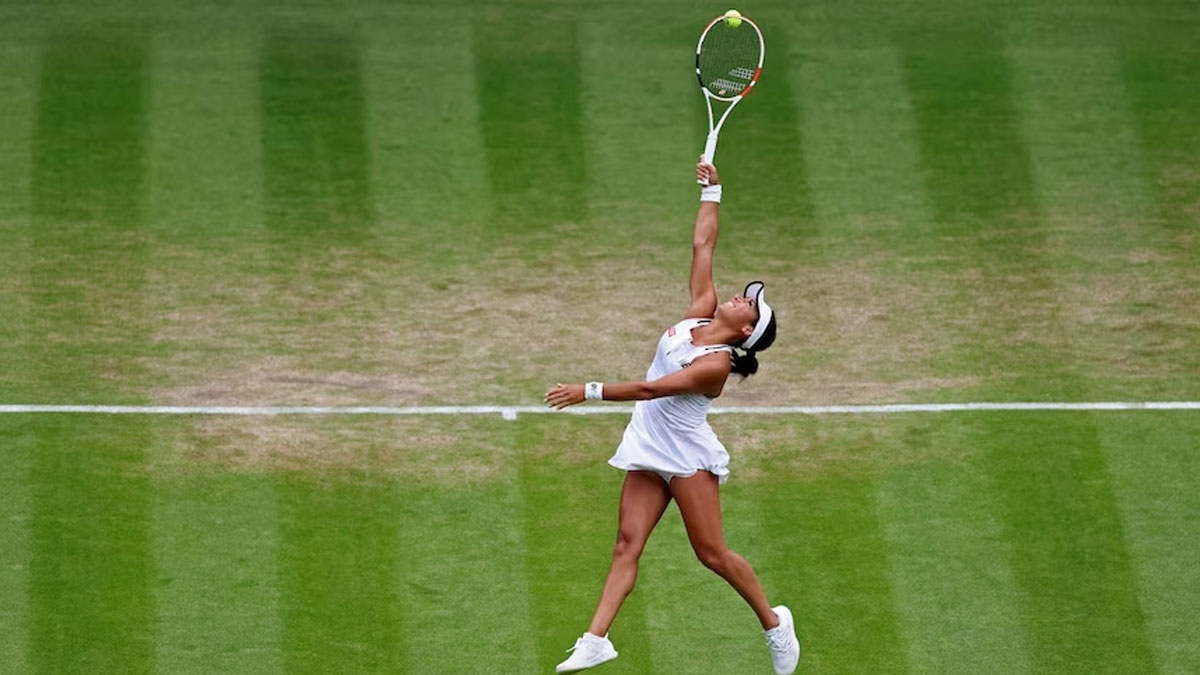
As players step onto the grass courts of the All England Tennis Club for the first round of Wimbledon, there will be a small but significant change to the crisp white aesthetic.
The tournament is renowned for upholding tradition — from strawberries and cream to the iconic all-white uniform.
Players have been required to wear white at the event since 1877, and the dress code rules are extremely strict.
Off-white and cream are not allowed, and "a single trim of colour" — no more than a centimetre — is permitted on the neckline or sleeve cuff.
But from now on, women will be able to make a subtle departure from the Wimbledon whites.
In a change announced late last year, female players now have the option of wearing dark-coloured undershorts, provided they are no longer than their shorts or skirt.
It's a small change, but it's one that has been hailed as a win for women competing at an elite level while on their period.
"It is our hope that this rule adjustment will help players focus purely on their performance by relieving a potential source of anxiety," All England Club CEO Sally Bolton said.
Some players have been outspoken about using hormonal contraceptives to avoid menstruating during the tournament.
Others have said concerns about blood seeping through their white undergarments was an unnecessary added stress when they were trying to outmatch their opponent across the net.
Players have also spoken about using toilet breaks to check their clothing during their matches, or developing a signal with their support team who could alert them if their bleeding became visible through their clothes.
'I went on the pill to stop myself bleeding' British tennis player Heather Watson, who broke a taboo by speaking about how her period impacted her performance at the Australian Open back in 2015, told Sky News UK she welcomed the change.
"Last year … I went on the pill to stop myself bleeding because I knew we had to wear white undershorts, and I didn't want to face any embarrassment," she said.
"We're running around, sweating, doing the splits on the court. This year, I knew my period was going to be during Wimbledon again, so I'm very happy that I won't have to do the same thing as last year."
Australian Daria Saville last year told The Daily Aus she too had to "skip" her period during Wimbledon.
"One time I got a period mid-match. I went to the bathroom and then was like oh surprise," she said in an Instagram comment on the outlet's post.
"Thank god I had a female umpire. I explained to her what is happening and then I waited for someone to bring me a tampon because I didn't have any. This happened during my first ever Australian Open in the second round. It was also 38 degrees on that day."
US tennis star Coco Gauff told Sky News UK she had had an incident at another tournament in the past, but that it was noticed by the referee before anyone else saw.
She said while no-leak period undies helped, "It's still in the back of your mind", and she welcomed the move.
"I think it's going to relieve a lot of stress for me, and other girls in the locker room, for sure," she said.
Dr Brianna Larsen, a lecturer of sport and exercise science at the University of Southern Queensland, said it was a small step in the right direction, but Wimbledon could have gone further, as players are still required to wear white skirts, shorts or dresses.
Still, she told ABC News Radio the change showed the tournament organisers were listening to players' concerns.
"It's about giving female athletes the opportunity to perform at their best," she said.
"Even if it's just a small added extra anxiety, it's just something that might detract female athletes if they're playing in Wimbledon when they're on their period.
"Female athletes have higher rates of menstrual dysfunction. And they also have higher rates of hormonal contraceptive use, and many of them cite the ability to actually manipulate their cycle as a primary reason for their hormonal contraceptive use."
She said more research needs to be done on the impact periods have on women in sport, and that it can vary greatly.
Some female athletes in other sports have spoken about being encouraged to train until they lose their period — a mark of their elite level.
The dress code development comes amid moves to address pay inequality in the sport.
Although men and women earn equal prize money at grand slam tournaments like Wimbledon, men earn more at competitions on the Association of Tennis Professionals (ATP) tour.
That's something the Women's Tennis Association (WTA) said it will address, announcing last week it would aim for equal prize money in the coming years.
Wimbledon's strict dress code has also made headlines in the past.
In 2007, Tatiana Golovin wore red undershorts, leading some to write that Wimbledon was "getting its knickers in a twist".
The tournament tightened the dress code further in 2014.
In 2017, Venus Williams changed her bra mid-match after her bright-pink straps became visible during play.
Williams, 43, who has won the championship five times, is returning to the tournament this year, 26 years after she made her Wimbledon debut.
Australian Nick Kyrgios, who was seeded at the tournament but pulled out at the eleventh hour with a wrist injury, wore a red cap while accepting his runner-up trophy on centre court last year.
Story by Erin Handley
Original story link https://www.abc.net.au/news/2023-07-03/wimbledon-whites-rule-change-women-period-female-athletes/102554006
Stay tuned for the latest news on our radio stations


